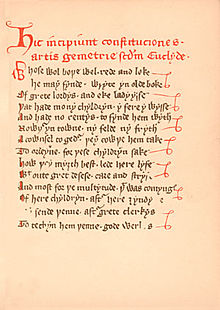Regius manuscript
The Regius manuscript or Halliwell manuscript from 1390 is the oldest known guild order of the stonemasonry brotherhoods . It is also called the “Masonic Poem”. The text, written on parchment and bound in Russian leather , contains 794 rhymes in Middle English, depicting the origins of the stonemasons' guild in England and the rules of the guild. It reports that the Anglo-Saxon King Äthelstan (925-939) gave the bricklayers in England his special favor and encouraged their associations. The purpose of the manuscript was to familiarize the young craftsmen with the rules and duties of the brotherhood and to make it easier to memorize them. The manuscript is now in the manuscript collection of the British Library , London .
Emergence
The origin of the manuscript is essentially unknown. It came into the possession of the British Library in 1757 under King George II as part of the royal manuscript collection. The importance for Freemasonry was first recognized in 1734 by the librarian David Casley, who cataloged it as ... Poem of Moral Duties (German: a poem about moral duties). Its existence was forgotten until the literary historian James Orchard Halliwell-Phillipps re -explored it. Halliwell referred to it in a lecture to the Society of Antiquaries on the origins of Freemasonry as a "Masonic poem".
content
The poem entitled “Here begin the constitutions of the art of geometry according to Euclid” begins with 15 so-called articles that describe the origin of masonry and general rules of the craft. This is followed by 15 so-called “further constitutions”, in which the special duties of the craftsmen are defined. These include a. the weekly working hours and remuneration, the protection of professional secrets, the obligation to follow the rules of the building trade, the oath of professional duties and the exclusion from the guild in case of violation of these obligations. This is followed by the “Further Ordinance on the Art of Geometry”. Furthermore, the story "The Art of the Four Crowns" is told, in which four master builders refused to attach "idols" to a sacred building. Despite the threatened punishments, they persevered, which is why they are to be commemorated with a festival on November 9th. Verse 538f contains a representation of the seven liberal arts of antiquity.
Freemasonry
For Freemasonry, which sees its origins in the old stonemasonry guilds, the manuscript represents part of the so-called old duties . A translation into German suggested by Karl Christian Kanis Gretschel was published in 1842 by Hermann Marggraff .
See also
literature
- James Orchard Halliwell: Prehistory of Freemasonry in England. German by Hermann Marggraff. Franz Peter, Leipzig 1842
Web links
- The Halliwell Manuscript. Grand Lodge of British Columbia and Yukon AF & AM, February 2, 2014, accessed December 2, 2014 . (English)
- Hermann Marggraff: Regius manuscript (German translation). Freemasons Wiki, October 23, 2014, accessed September 9, 2014 .
- William James Hughan: The Old Charges of British Freemasons. The Masonic High Council / The Mother High Council, accessed December 2, 2014 . (English) PDF 6.1 MB
